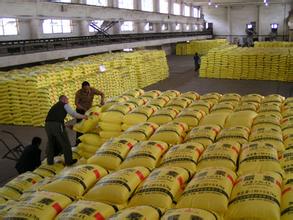In
July and Aug. 2016, influenced by the EI Nino, there were heavier rains than
usual in Southern China, leading to different degrees of flood disasters and
significantly harming agricultural production in many regions. As a result,
China’s ammonium phosphate market remained stagnant and transitions were very limited
even if the fertiliser storage for increasing demand in autumn had already
begun.

Source: Baidu
- Monoammonium phosphate (MAP)
Sales were dull and the market price kept falling. As of mid-Aug. 2016, the
average quotation for 55% MAP powder stood at USD252/t (RMB1,670/t), down 1.76%
MoM. The main reason for this was that compound fertiliser manufacturers had
sufficient inventory and purchased limited MAP, according to trade source.
- Diammonium phosphate (DAP)
The domestic market was so depressed and manufacturers suffered heavy pressure
from their inventory and from downstream companies’ requests for lower prices.
As of mid-Aug. 2016, the average quotation for 64% DAP was USD338/t
(RMB2,240/t), down by 6.67% MoM. In this context, many manufacturers mainly focused
on their export business. However, there were also limited new orders. The FOB
price was between USD327-330/t.
“DAP manufacturers are facing more serious challenges in sales than in previous
years. The market price may continue to fall considering that market conditions
will not recover in the short term,” commented trade source to CCM, “What’s
worse, the ex-works price of 64% DAP in some regions may even drop to as low as
USD302/t (RMB2,000/t).”

According
to CCM’s research, recently, the Chinese government has been carrying out
environmental protection inspection in chemical fertiliser enterprises in Henan
Province and then in Hubei Province later. According to trade source, many
enterprises have been forced to suspend production for transformation and
upgrade so far. This helps to ease overcapacity in the market and ammonium
phosphate manufacturers are able to reduce inventory more quickly, supporting
the market to recover.
In addition, from 1 July, 2016, phosphorus ore is taxed by value instead of by
volume, the mineral compensation expenses of all resource categories are cut
down to zero, collection of the price regulation fund is stopped and the local
charging funds set up illegally and targeted at minerals are cancelled.
These are favourable for phosphorus ore enterprises and help them reduce
production costs. For phosphate fertiliser enterprises, their costs for
purchasing phosphorus ore also decline which means bigger profit margins for
them. For example, Hubei Xingfa Chemicals Group Co., Ltd. expected to reduce
its tax by USD3.02 million (RMB20 million) in 2016 after the phosphorus ore
resource tax rate was cut from 10% to 7%.
This
article comes from Phosphorus Industry China Monthly Report 1608, CCM

About CCM:
CCM is the leading market
intelligence provider for China’s agriculture, chemicals, food &
ingredients and life science markets. Founded in 2001, CCM
offers a range of data and content solutions, from price and trade data to
industry newsletters and customized market research reports. Our clients include
Monsanto, DuPont, Shell, Bayer, and Syngenta. CCM is a brand of Kcomber Inc.
For
more information about CCM, please visit www.cnchemicals.com or
get in touch with us directly by emailing econtact@cnchemicals.com or
calling +86-20-37616606.
Tag: fertiliser phosphate